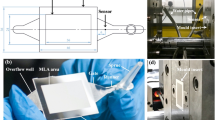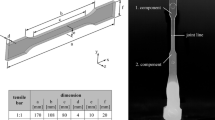Abstract
Condition monitoring of micro injection moulding is an effective way of understanding the processing effects of variable parameter settings. This paper reports an experimental study that investigates the characteristics of the demoulding behaviour in micro injection moulding (µ-IM) with a focus on the process factors that affect parts’ quality. Using a Cyclic Olefin Copolyme (COC) microfluidics demonstrator, the demoulding performance was studied as a function of four process parameters (melt temperature, mould temperature, holding pressure and injection speed), employing the design of experiment approach. The results provide empirical evidences on the effect that processing parameters have on demoulding conditions in µ-IM, and identifies combinations of parameters that can be used to achieve the optimal processing conditions in regards to demoulding behaviour of micro parts. It was concluded that there was a direct correlation between the applied pressure during part filling, holding phases and the demoulding characteristic factors of the µ-IM cycle such as ejection force, integral and time.



















Similar content being viewed by others
Abbreviations
- ANOVA:
-
Analysis of variance
- ABS:
-
Acrylonitrile butadiene styrene
- COC:
-
Cyclic olefin copolymer
- d:
-
Measuring pin diameter
- DOE:
-
Design of experiments
- IM:
-
Injection moulding
- OA:
-
Orthogonal array
- PC:
-
Polycarbonate
- PVT:
-
Pressure volume temperature
- Fe :
-
Demoulding force
- \( {\text{F}}_{{\rm max} }^{\text{e}} \) :
-
Maximum demoulding force
- \( {\text{F}}_{\text{work}}^{\text{e}} \) :
-
Demoulding force work
- \( {\text{F}}_{\text{rate}}^{\text{e}} \) :
-
Demoulding force rate
- Ph :
-
Holding pressure
- S/N:
-
Signal to noise ratio
- SVR :
-
Surface to volume ratio
- t:
-
Time
- Tb :
-
Melt/barrel temperature
- th :
-
Holding pressure time
- Tm :
-
Mould/tool temperature
- Tg :
-
Glass transition temperature
- Vi :
-
Injection speed
- Δt :
-
Time step of data acquisition system
- δ:
-
Relative effect
- σ:
-
Standard deviation
- μ-IM:
-
Micro-injection moulding
References
Chen SC, Chang Y, Chang TH, Chien RD (2008) Influence of using pulsed cooling for mold temperature control on microgroove duplication accuracy and warpage of the Blu-ray disc. Int Commun Heat Mass Transfer 35(2):130–138
Chen SC, Chang Y, Chang YP, Chen YC, Tseng CY (2009a) Effect of cavity surface coating on mold temperature variation and the quality of injection molded parts. Int Commun Heat Mass Transfer 36(10):1030–1035
Chen SC, Wang YC, Liu SC, Cin JC (2009b) Mold temperature variation for assisting micro-molding of DVD micro-featured substrate and dummy using pulsed cooling. Sens Actuators A 151(1):87–93
Chen CS, Chen SC, Liao WH, Chien RD, Lin SH (2010) Micro injection molding of a micro-fluidic platform. Int Commun Heat Mass Transfer 37(9):1290–1294
Chen SC, Chang JA, Hsu WY, Sung W, Huang SW (2011) Improvement of replication accuracy of micro-featured molding using gas-assisted heating for mold surface. Microelectron Eng 88(7):1594–1600
Delaunay D, Le Bot P, Fulchiron R, Luye JF, Regnier G (2000) Nature of contact between polymer and mold in injection molding. Part II: influence of mold deflection on pressure history and shrinkage. Polym Eng Sci 40(7):1692–1700
Dhouib K, Malek CK, Pfleging W, Gauthier-Manuel B, Duffait R, Thuillier G, Ferrigno R, Jacquamet L, Ohana J, Ferrer JL, Theobald-Dietrich A, Giege R, Lorbera B, Sauter C (2009) Microfluidic chips for the crystallization of biomacromolecules by counter-diffusion and on-chip crystal X-ray analysis. Lab Chip 9(10):1412–1421
Griffiths CA, Dimov SS, Brousseau EB, Chouquet C, Gavillet J, Bigot S (2009) Investigation of surface treatment effects in micro-injection-moulding. Int J Adv Manuf Technol 47(1–4):99–110
Griffiths CA, Dimov SS, Scholz S, Tosello G (2011) Process factors influence on cavity pressure behaviour in micro-injection moulding. ASME Trans J Manuf Sci Eng 133(3):031007
Hansen HN, Hocken R, Tosello G (2011) Replication of micro/nano geometries. Ann CIRP (International Academy for Production Engineering) 60(2):695–714
Kim SK, Choi SJ, Lee KH, Kim DJ, Yoo YE (2010) Observation of instabilities in flow front during micro injection molding process. Polym Eng Sci 50(7):1377–1381
Leo V, Cuvelliez Ch (1996) The effect of the packing parameters, gate geometry, and mold elasticity on the final dimensions of a molded part. Polym Eng Sci 36(15):1961–1971
Lin HY, Chang CH, Young WB (2010) Experimental and analytical study on filling of nano structures in micro injection molding. Int Commun Heat Mass Transfer 37(10):1477–1486
Lucchetta G, Bariani PF (2010) Sustainable design of injection moulded parts by material intensity reduction. CIRP Ann Manuf Technol 59(1):33–36
Montgomery D (2004) Design and analysis of experiments, 6th edn. Wiley, ISBN: 047148735X, pp 1–450
Ogilvie RG, Sieben VJ, Floquet CFA, Zmijan R, Mowlem MC, Morgan H (2010) Reduction of surface roughness for optical quality microfluidic devices in PMMA and COC. J Micromech Microeng 20(6):065016–065024
Ong NS, Koh YH, Fu YQ (2002) Micro lens array produced using hot embossing process. Microelectron Eng 60(3–4):365–379
Panchal RR, Kazmer DO (2010) In-situ shrinkage sensor for injection molding. J Manuf Sci Eng 132(6):064503–064509
Schütte J, Freudigmann C, Benz K, Jan Bottger Gebhardt R, Stelzle M (2010) A method for patterned in situ biofunctionalization in injection-molded microfluidic devices. Julia Lab Chip 10:2551–2558
Shen C, Wang L, Li Q (2007) Optimization of injection molding process parameters using combination of artificial neural network and genetic algorithm method. J Mater Process Technol 183(2–3):412–418
Topas Advanced Polymers GmbH (Frankfurt am Main, Germany) (2006) TOPAS cyclic olefin copolymers (COC)—product brochure. http://www.topas.com/ (Accessed Dec 2013)
Zhang HL, Ong NS, Lam YC (2008) Experimental investigation of key parameters on the effects of cavity surface roughness in microinjection molding. Polym Eng Sci 48(3):490–495
Acknowledgments
The research reported in this paper was funded by the FP7 programmes “Converging technologies for micro systems manufacturing” (COTECH, Grant agreement CP-IP 214491-2, http://www.fp7-cotech.eu/), “Integrating European research infrastructures for the micro-nano fabrication of functional structures and devices out of a knowledge-based multimaterials’ repertoire” (EUMINAfab, Grant agreement FP7-226460, http://www.euminafab.eu/), “High throughput integrated technologies for multimaterial functional Micro Components” (HINMICO, Grant agreement 609110, http://www.hinmico.eu/), the UK Engineering and Physical Sciences Research Council (EP/F056745/1) and the MicroBridge programme supported by Welsh Assembly Government and the UK Department for Business, Enterprise and Regulatory Reform.
Author information
Authors and Affiliations
Corresponding author
Rights and permissions
About this article
Cite this article
Griffiths, C.A., Tosello, G., Dimov, S.S. et al. Characterisation of demoulding parameters in micro-injection moulding. Microsyst Technol 21, 1677–1690 (2015). https://doi.org/10.1007/s00542-014-2269-6
Received:
Accepted:
Published:
Issue Date:
DOI: https://doi.org/10.1007/s00542-014-2269-6




